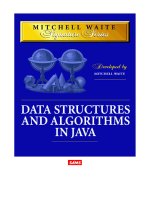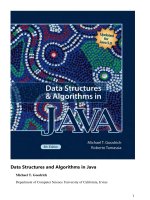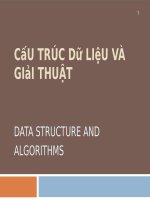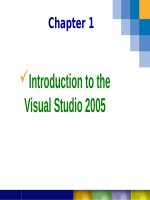Data Structure and Algorithms CO2003 Chapter 1 Introduction
Bạn đang xem bản rút gọn của tài liệu. Xem và tải ngay bản đầy đủ của tài liệu tại đây (348.34 KB, 44 trang )
Data Structure and Algorithms [CO2003]
Chapter 1 - Introduction
Lecturer: Duc Dung Nguyen, PhD.
Contact:
August 15, 2016
Faculty of Computer Science and Engineering
Hochiminh city University of Technology
Contents
1. Basic concepts
2. Revision
1
Basic concepts
What is Data?
2
What is Data?
Data
Data is information that has been translated into a form that is more
convenient to calculate, analyze.
Example
• Numbers, words, measurements, observations or descriptions of
things.
• Qualitative data: descriptive information,
• Quantitative data: numerical information (numbers).
• Discrete data can only take certain values (like whole numbers)
• Continuous data can take any value (within a range)
3
Data type
Class of data objects that have the same properties.
Data type
1. A set of values
2. A set of operations on values
Example
Type
integer
floating point
character
Values
Operations
−∞, ..., −2, −1,
0, 1, 2, ..., ∞
−∞, ..., 0.0, ..., ∞
\0, ..., ‘A’, ‘B’, ...,
‘a’, ‘b’, ..., ∼
∗, +, −, %, /,
++, −−, ...
∗, +, −, /, ...
<, >, ...
4
Data structure
What is a data structure?
1. A combination of elements in which each is either a data type or
another data structure
2. A set of associations or relationships (structure) that holds the data
together
Example
An array is a number of elements of the same type in a specific order.
1
2
3
5
8
13
21
34
5
Abstract data type
The concept of abstraction:
• Users know what a data type can do.
• How it is done is hidden.
Definition
An abstract data type is a data declaration packaged together with the
operations that are meaningful for the data type.
1. Declaration of data
2. Declaration of operations
3. Encapsulation of data and operations
6
Abstract data type
Figure 1: Abstract data type model (source: Slideshare)
7
Example: List
Interface
• Data: sequence of elements of a particular data type
• Operations: accessing, insertion, deletion
Implementation
• Array
• Linked list
8
Algorithm
What is an algorithm?
The logical steps to solve a problem.
What is a program?
Program = Data structures + Algorithms (Niklaus Wirth)
9
Pseudocode
• The most common tool to define algorithms
• English-like representation of the algorithm logic
• Pseudocode = English + code
• English: relaxed syntax being easy to read
• Code: instructions using basic control structures (sequential,
conditional, iterative)
10
Pseudocode
Algorithm Header
• Name
• Parameters and their types
• Purpose: what the algorithm does
• Precondition: precursor requirements for the parameters
• Postcondition: taken action and status of the parameters
• Return condition: returned value
Algorithm Body
• Statements
• Statement numbers: decimal notation to express levels
• Variables: important data
• Algorithm analysis: comments to explain salient points
• Statement constructs: sequence, selection, iteration
11
Pseudocode: Example
Algorithm average
Pre nothing
Post the average of the input numbers is printed
i=0
sum = 0
while all numbers not read do
i=i+1
read number
sum = sum + number
end
average = sum / i
print average
End average
Algorithm 1: How to calculate the average
12
Revision
Data structures
Data structures can be declared in C++ using the following syntax:
s t r u c t [ type_name ] {
member_type1 member_name1 ;
member_type2 member_name2 ;
member_type3 member_name3 ;
...
} [ object_names ] ;
• Where type_name is a name for the structure type, object_names
can be a set of valid identifiers for objects that have the type of this
structure.
• Within braces { }, there is a list with the data members, each one is
specified with a type and a valid identifier as its name.
• struct requires either a type_name or at least one name in
object_names, but not necessarily both.
13
Data structures
Example
s t r u c t car_t {
int year ;
s t r i n g brand ;
};
car_t t o y o t a ;
car_t mercedes , bmw ;
Example
struct {
int year ;
s t r i n g brand ;
} t o y o t a , mercedes , bmw ;
14
Data structures
A member of an object can be accessed directly by a dot (.) inserted
between the object name and the member name.
Example
toyota . year
toyota . brand
mercedes . year
mercedes . brand
bmw . y e a r
bmw . b r a n d
• toyota.year, mercedes.year, and bmw.year are of type int.
• toyota.brand, mercedes.brand, and bmw.brand are of type
string.
15
Data structures
Example
// e x a m p l e a b o u t s t r u c t u r e s
#i n c l u d e <i o s t r e a m >
u s i n g namespace s t d ;
s t r u c t car_t {
int year ;
s t r i n g brand ;
} mycar ;
i n t main ( ) {
mycar . b r a n d = " Audi " ;
mycar . y e a r = 2 0 1 1 ;
c o u t << "My␣ f a v o r i t e ␣ c a r ␣ i s : " << e n d l ;
c o u t << mycar . b r a n d << " ␣ ( " << mycar . y e a r << " ) " ;
return 0;
}
16
Data structures
Example
#i n c l u d e <i o s t r e a m >
u s i n g namespace s t d ;
s t r u c t car_t {
int year ;
s t r i n g brand ;
} mycar ;
v oi d p r i n t c a r ( car_t ) ;
i n t main ( ) {
mycar . b r a n d = " Audi " ;
mycar . y e a r = 2 0 1 1 ;
p r i n t c a r ( mycar ) ;
return 0;
}
v oi d p r i n t c a r ( car_t c ) {
c o u t << "My␣ f a v o r i t e ␣ c a r ␣ i s : " << e n d l ;
c o u t << c . b r a n d << " ␣ ( " << c . y e a r << " ) " ;
}
17
Data structures
Exercise
• Define a data structure student_t containing a student’s name,
firstname and age.
• Write a code in C++ to take input your data and display it.
18
Data structures
Exercise
#i n c l u d e <i o s t r e a m >
#i n c l u d e <s s t r e a m >
u s i n g namespace s t d ;
s t r u c t student_t {
s t r i n g name ;
string firstname ;
i n t age ;
};
void i n f o s t u d e n t ( student_t ) ;
i n t main ( ) {
student_t sv ;
string str ;
c o u t << " E n t e r ␣ y o u r ␣name : ␣ " ;
g e t l i n e ( c i n , s v . name ) ;
c o u t << " E n t e r ␣ y o u r ␣ f i r s t n a m e : ␣ " ;
g e t l i n e ( cin , sv . fi rs tname ) ;
c o u t << " E n t e r ␣ y o u r ␣ a ge : ␣ " ;
g e t l i n e ( cin , s t r ) ;
s t r i n g s t r e a m ( s t r ) >> s v . a ge ;
i n f o s t u d e n t ( sv ) ;
return 0;
}
void i n f o s t u d e n t ( student_t s ) {
c o u t << "My␣name␣ i s ␣ " << s . name << " ␣ " << s . f i r s t n a m e << e n d l ;
c o u t << " I ␣am␣ " << s . a g e << " ␣ y e a r s ␣ o l d . " << e n d l ;
}
19
Classes
Classes are defined using keyword class, with the following syntax:
c l a s s class_name {
a c c e s s _ s p e c i f i e r _ 1 : member1 ;
a c c e s s _ s p e c i f i e r _ 2 : member2 ;
...
} object_names ;
• Where class_name is a valid identifier for the class, object_names
is an optional list of names for objects of this class.
• The body of the declaration can contain members, which can either
be data or function declarations, and optionally
access_specifiers.
20
Classes
Example
class Rectangle {
i n t width , h e i g h t ;
public :
void set_v alues ( int , i n t ) ;
i n t area ( void ) ;
} rect ;
21
Classes
Example
#i n c l u d e <i o s t r e a m >
u s i n g namespace s t d ;
class Rectangle {
i n t width , h e i g h t ;
public :
void set_values ( int , int ) ;
int area ( void ) ;
};
void Rectangle : : set_values ( int x , int y ) {
width = x ;
height = y ;
}
int Rectangle : : area () {
r e t u r n w i d t h∗ h e i g h t ;
}
i n t main ( ) {
Rectangle rectA , rectB ;
rectA . set_values (3 ,4);
rectB . set_values (5 ,6);
c o u t << " r e c t A ␣ a r e a : ␣ " << r e c t A . a r e a ( ) << e n d l ;
c o u t << " r e c t B ␣ a r e a : ␣ " << r e c t B . a r e a ( ) << e n d l ;
return 0;
}
22









